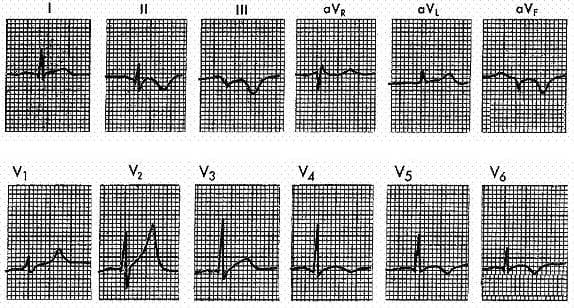Exam Details
Exam Code
:040-444Exam Name
:ACSM Registered Clinical Exercise PhysiologistCertification
:ACSM CertificationsVendor
:ACSMTotal Questions
:370 Q&AsLast Updated
:Jul 05, 2025
ACSM ACSM Certifications 040-444 Questions & Answers
-
Question 11:
Differentiation between supraventricular and ventricular rhythm is made on the basis of the
A. Duration (width) of the QRS complex and the presence or absence of P waves.
B. Appearance of the ST segment.
C. Amplitude of the U wave.
D. Duration of the PR interval.
-
Question 12:
Abnormally tall and peaked T waves suggest which of the following?
A. Hyperkalemia.
B. Acutepericarditis.
C. Acute MI.
D. Hypokalemia.
-
Question 13:
Which of the following conditions can prolong the QT interval?
A. Hypokalemia and hypercalcemia.
B. Hyperkalemia and hypercalcemia.
C. Hypocalcemia and hypokalemia.
D. Hypocalcemia and hyperkalemia.
-
Question 14:
In the ECG strip shown below, which arrhythmia is indicated?

A. Atrial flutter.
B. Atrial fibrillation.
C. Prematureatrial contractions.
D. Atrial tachycardia.
-
Question 15:
Subendocardial ischemia usually produces
A. ST-segment elevation.
B. ST -segment depression.
C. Q waves.
D. U waves.
-
Question 16:
In the ECG strip shown below, which arrhythmia is present?

A. Premature ventricular contractions.
B. Ventricular tachycardia.
C. Ventriculartrigeminy.
D. Ventricularbigeminy. (From Goldberger AL: Clinical Electrocardiography: A Simplified Approach, 6th ed. 51. Louis, Mosby, 1999, p 167.)
-
Question 17:
In the ECG strip shown below, what disorder is indicated?

A. Subendocardial ischemia.
B. Transmural ischemia.
C. Acute inferior MI.
D. Posterior MI (From Goldberger AL: Clinical Electrocardiography: A Simplified Approach, 6th ed. St. Louis, Mosby, 1999,p91.)
-
Question 18:
In the ECG strip shown below, what abnormality is indicated?


A. LBBB.
B. Posterior wall MI.
C. RBBB.
D. LVH. (From Goldberger AL: Clinical Electrocardiography: A Simplified Approach, 6th ed. St. Louis, Mosby, 1999, p 70.)
-
Question 19:
What condition can cause ST-segment elevation?
A. Digitalis toxicity.
B. Hypocalcemia.
C. Hypokalemia.
D. Acutepericarditis.
-
Question 20:
In the ECG strip shown below, what disorder is indicated?


A. Acutepericarditis.
B. Inferior MI.
C. Posterior MI.
D. Anterior MI. (From Goldberger AL: Clinical Electrocardiography: A Simplified Approach, 6th ed. St. Louis, Mosby, 1999, p 91.)
Tips on How to Prepare for the Exams
Nowadays, the certification exams become more and more important and required by more and more enterprises when applying for a job. But how to prepare for the exam effectively? How to prepare for the exam in a short time with less efforts? How to get a ideal result and how to find the most reliable resources? Here on Vcedump.com, you will find all the answers. Vcedump.com provide not only ACSM exam questions, answers and explanations but also complete assistance on your exam preparation and certification application. If you are confused on your 040-444 exam preparations and ACSM certification application, do not hesitate to visit our Vcedump.com to find your solutions here.